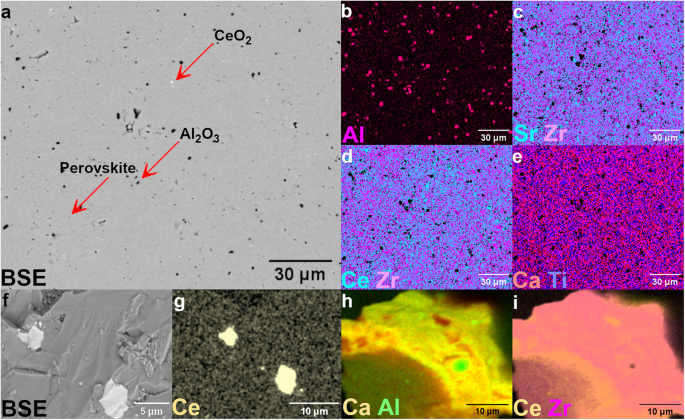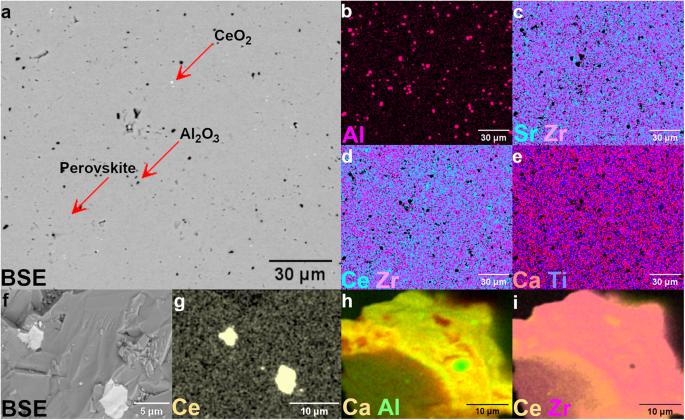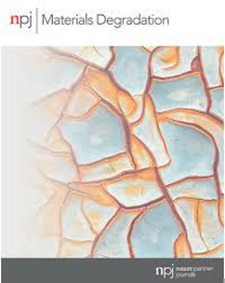未检测到的透辉石相对锆英石溶解度测量的干扰
IF 7.6
2区 材料科学
Q1 MATERIALS SCIENCE, MULTIDISCIPLINARY
引用次数: 0
摘要
锆英石陶瓷是一种化学性质持久的废弃锕系元素宿主基体,但文献中报道的锆英石溶解率往往差异很大。在这里,热等静压锆英石(Ca0.8Zr0.9Ce0.3Ti1.6Al0.4O7.0)中钙和铝的释放主要是由次要的包晶和氧化铝相的优先溶解所驱动的。XRD 无法检测到这两种相,SEM-EDS 也很难检测到包晶。锆沸石相没有发生变化的迹象,而透辉石的溶解过程则是一致的,没有形成水合变化层,也没有质子扩散到固体中,这表明存在离子交换机制。溶解的微弱温度依赖性(40、90 和 150 °C)表明,动力学分别受限于钙和铝的传输和混合传输-表面控制反应。在所有温度下,钙的溶解都受到 H2O-D2O 同位素的明显影响,而铝则没有。前者与在没有扩散作用的情况下水解速度减慢相一致,而后者则可归因于通过水解释放钙和铝的活化复合物的差异。这些结果表明了次生相包晶在锆英石溶解动力学中的作用,即使包晶的浓度很低,并且无法通过 XRD 等体型技术检测到。这项研究为文献中锆英石陶瓷溶解速率的变化提供了一个潜在的解释,并为锆英石不一致的钙释放机制测试提供了一个无效的结果。本文章由计算机程序翻译,如有差异,请以英文原文为准。


Undetected perovskite phase interference with zirconolite dissolution measurements
Zirconolite ceramics present a chemically durable host matrix for waste actinides, but zirconolite dissolution rates reported in the literature often vary significantly. Here, the release of Ca and Al from a hot isostatically pressed zirconolite (Ca0.8Zr0.9Ce0.3Ti1.6Al0.4O7.0) was shown to be predominantly driven by preferential dissolution of minor perovskite and alumina phases. Both phases were undetectable by XRD, and the perovskite was difficult to detect by SEM-EDS. Whilst the zirconolite phase exhibited no signs of alteration, dissolution of the perovskite proceeded congruently without forming a hydrated altered layer or diffusion of protons into the solid that would be indicative of an ion-exchange mechanism. The weak temperature dependence of dissolution (40, 90 and 150 °C) showed that kinetics were limited by transport and a mixed transport-surface controlled reaction for Ca and Al, respectively. A significant H2O-D2O isotope effect on dissolution was observed for Ca but not for Al at all temperatures. The former was consistent with an abated rate of hydrolysis in the absence of a contribution from diffusion, whilst the latter could be attributed to differences in the activated complex for Ca and Al release through hydrolysis. These results demonstrate the role of a secondary phase perovskite in the dissolution kinetics of zirconolite even when perovskite occurs at low concentration and evades detection by bulk techniques such as XRD. This study provides a potential explanation of variations in zirconolite ceramic dissolution rates present in the literature and provides a null result to tests of an incongruent Ca release mechanism from zirconolite.
求助全文
通过发布文献求助,成功后即可免费获取论文全文。
去求助
来源期刊

npj Materials Degradation
MATERIALS SCIENCE, MULTIDISCIPLINARY-
CiteScore
7.80
自引率
7.80%
发文量
86
审稿时长
6 weeks
期刊介绍:
npj Materials Degradation considers basic and applied research that explores all aspects of the degradation of metallic and non-metallic materials. The journal broadly defines ‘materials degradation’ as a reduction in the ability of a material to perform its task in-service as a result of environmental exposure.
The journal covers a broad range of topics including but not limited to:
-Degradation of metals, glasses, minerals, polymers, ceramics, cements and composites in natural and engineered environments, as a result of various stimuli
-Computational and experimental studies of degradation mechanisms and kinetics
-Characterization of degradation by traditional and emerging techniques
-New approaches and technologies for enhancing resistance to degradation
-Inspection and monitoring techniques for materials in-service, such as sensing technologies
 求助内容:
求助内容: 应助结果提醒方式:
应助结果提醒方式:


